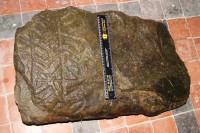 Archaeologists on a walk stumbled on a long-lost inscribed stone dating to the 9th or 10th century in the Nant Tawelan river in the village of Silian, County Ceredigion, mid-west Wales. Nikki Vousden, staff member of the Royal Commission on the Ancient and Historical Monuments of Wales, and University of Wales archaeologist Dr. Roderick Bale were taking a stroll along the stream one bank holiday when they noticed one of the wet stones had an inscription. The water glinting off the surface highlighted the unusual pattern: a linear Latin cross with a lozenge shaped ring at the upper end.
Archaeologists on a walk stumbled on a long-lost inscribed stone dating to the 9th or 10th century in the Nant Tawelan river in the village of Silian, County Ceredigion, mid-west Wales. Nikki Vousden, staff member of the Royal Commission on the Ancient and Historical Monuments of Wales, and University of Wales archaeologist Dr. Roderick Bale were taking a stroll along the stream one bank holiday when they noticed one of the wet stones had an inscription. The water glinting off the surface highlighted the unusual pattern: a linear Latin cross with a lozenge shaped ring at the upper end.
There are only three stones known with a cross and lozenge pattern. One of them is at St. David’s Church in Llanllawer, the other at St. Tecwyn’s Church, Llandecwyn, and the third has been missing for longer than anyone knows. Its existence was documented by Dr. Victor Erle Nash-Williams in his 1950 reference The Early Christian Monuments of Wales, but his sources were a cast of the surface and a photograph of the stone kept at the National Museum of Wales. A label on the picture identified the stone as coming from Silian, but there was no record of who took the photograph, who made the cast or the context of the original find.
So at some point somebody knew it was historically significant enough to make a cast of the inscription. How the stone went from museum cast-worthy to sitting in a stream 40 miles south of St. Sulien’s Church, Silian, is a mystery. The stone is being kept at St. Sulien’s right now, which has two other inscribed stones. The earliest, inscribed “Silbandus lies” with a linear Latin cross superimposed over the words, dates to the 7th-9th century and is now built into the church’s external south wall. The second dates to the 9th or 10th century and has a pattern of linked knots on one side and square frets on the other. It was discovered in the churchyard in 1808 and was moved to the interior south wall of the church in 1960.
 The newly rediscovered stone is called Silian 3 because it’s the third of St. Sulien’s three stones. Silian 3’s inscription is made of punch marks clustered close together. The design wasn’t carved into the surface with a chisel; it was punched out in divots with a metal tool. According to Professor Nancy Edwards of Bangor University, author of the three-volume A Corpus of Early Medieval Inscribed Stones and Stone Sculpture in Wales, the Silian 3 inscription is unique. Although they share the cross and lozenge imagery, the other two stones are different in overall pattern.
The newly rediscovered stone is called Silian 3 because it’s the third of St. Sulien’s three stones. Silian 3’s inscription is made of punch marks clustered close together. The design wasn’t carved into the surface with a chisel; it was punched out in divots with a metal tool. According to Professor Nancy Edwards of Bangor University, author of the three-volume A Corpus of Early Medieval Inscribed Stones and Stone Sculpture in Wales, the Silian 3 inscription is unique. Although they share the cross and lozenge imagery, the other two stones are different in overall pattern.
There are 534 documented early medieval inscribed stones and sculptures in Wales. Find sites cluster around churches and burial grounds. Some of the inscriptions indicate they were used as grave markers, and indeed there are extant stones that bear clear marks of having been embedded vertically into the ground. However, not a single inscribed stone has ever been discovered in context attached to a grave. Nancy Edwards believes (pdf), and inscriptions back her up, they were also used as boundary markers of church property, to record a donation of land to the church, or in the case of the larger works, as unmistakable signs of sacred ground. They may also have been placed along roadsides to serve as prayer stations, much like statues of saints and whatnot are still used in Italy to this day.
Your comment”how it got into a stream 40
miles south” is odd. The stone was in the stream bounding the churchyard in Silian. Its suspected the caretaker threw it there during a clear-out. J.Wilson-Bright ,May 2014